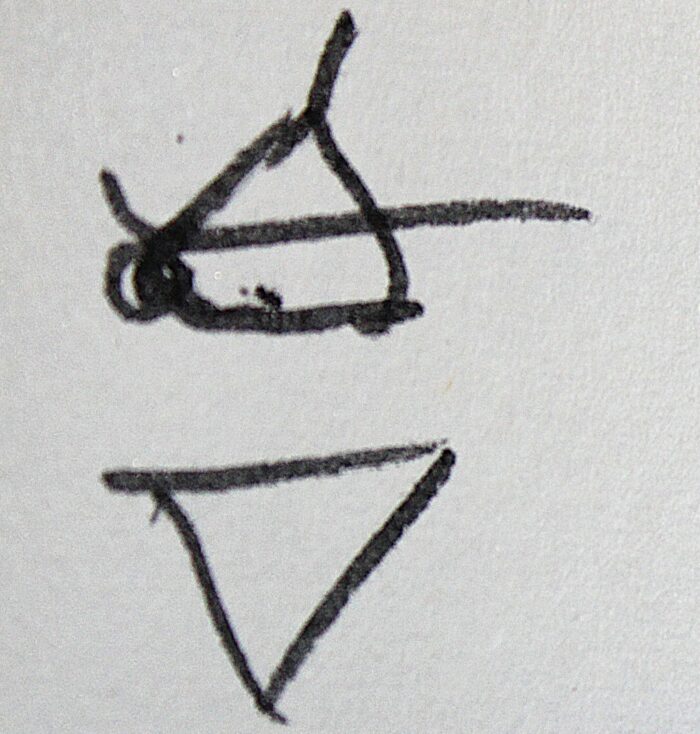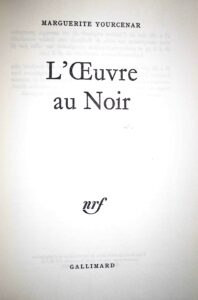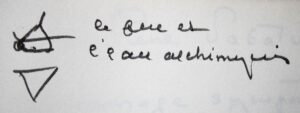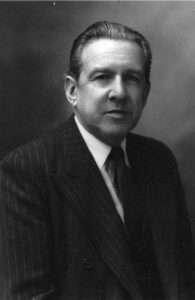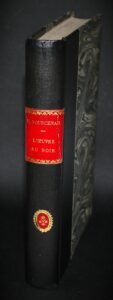Marguerite YOURCENAR. L’Œuvre au Noir. Paris, NRF, 1968. In-8°. 340, [2] pp. Binding to Bradel in black half-Rexine, title label and decorative label in red morocco leather, colour jacket and cover preserved.
Third edition published a few months after the original edition.
L’Œuvre au Noir recounts the life of Zénon, a doctor, alchemist and philosopher in 16th-century Europe. Marguerite Yourcenar explains in the “Note de l’auteur” that, in alchemical treatises, the formula given in the title refers to “the phase of separation and dissolution of the substance, which was said to be the most difficult part of the Great Work. There is still debate as to whether this expression applied to daring experiments on matter itself or was meant symbolically to refer to the trials of the mind freeing itself from routine and prejudice. No doubt it meant both, alternately or simultaneously”. Furthermore, she specifies in her radio interviews with P. de Rosbo that ‘the work in the dark is the period of dissolution and calcination of all the concepts, prejudices and notions on which we are accustomed to living’.
L’Œuvre au Noir, along with Mémoires d’Hadrien, is one of Marguerite Yourcenar’s major works; it was unanimously awarded the Prix Femina in the year of its publication.
With an exceptional autograph signed by the author on the half-title page: « à Pierre Sabatier, en hommage sympathique. Marguerite Yourcenar – vie et mort d’un homme libre. Montpellier, 1969 » [to Pierre Sabatier, in nice tribute. Marguerite Yourcenar – Life and Death of a Free Man. Montpellier, 1969] preceded, on the front of the cover page, two captioned symbols: « le feu et l’eau alchimiques » [alchemical fire and water]. Here, the author confuses the symbol of fire with that of air, thus unintentionally or instinctively associating these three closely related elements.
In her letter to Simon Sautier, dated 8 March 1970, Marguerite Yourcenar writes that ‘in L’Œuvre au Noir, the image of water is certainly favoured by the elemental thinking of alchemists, even though the element with which Zénon connects is above all fire.’ (Zénon, sombre Zénon, NRF, 2023, p. 614). The evocation of water, air and fire can be linked, on the one hand, to Zeno’s alchemical speculations in the forest of Houthuist, as he contemplated the tall trees: “In each of these plant pyramids, he found the hermetic hieroglyph of ascending forces, the sign of air, which bathes and nourishes these beautiful sylvan entities, and of fire, whose potential they carry within themselves, and which may one day destroy them ‘ (pp. 39-40), and on the other hand, from the passage in ’The Abyss” in which Zeno has an internal vision of the hermetic philosopher of water and fire (pp. 159-160).
Pierre Sabatier d’Espeyran (1892-1989), writer, composer, art and theatre critic, was a member and patron of the Montpellier Academy of Sciences and Letters, serving as its president in 1960 and 1969. His doctoral thesis in literature on L’Esthétique des Goncourt (The Aesthetics of the Goncourt) was awarded the Marcellin-Guérin Prize by the French Academy. As Jacques Balp described him in his 1991 tribute, ‘Pierre Sabatier d’Espeyran, this cultured, brilliant, seemingly jovial man, was always preoccupied with the problem of evil and the transience of life.’ He was therefore certainly very sensitive to L’Œuvre au Noir and to the accompanying dedication, presumably written during a lecture on the book given by Jean-Louis Gourg at the University of Montpellier: ‘Here [in Montpellier],’ writes Marguerite Yourcenar, ‘at a meeting of a medical society at the University, a professor read a “paper” on Zeno, and this allowed us to see how the Faculty worked and to get to know a few people there.’(Cf. Zénon, sombre Zénon, p. 362 note 2, 364 et 379).
A slight lick and minimal shock to the upper cuts.
An elegant copy, well bound with a beautiful and interesting inscription.
1 800 €
